What is NextBrowsers?
The cyber threat analysts have determined that NextBrowsers is a potentially unwanted application (PUA) belonging to the family of Browser hijackers. Browser hijackers are a kind of software that is created to change the internet browser settings without the knowledge or permission of the computer user, and it usually redirects the affected system’s web-browser to some advertisement-related webpages. A browser hijacker initiates numerous pop-ups, changes the default browser search provider or start page, generates multiple pop-up advertisements, installs multiple toolbars on the internet browser and redirects user web searches to its own web site. If your internet browser has been infected by a browser hijacker you may need to perform manual steps or use a malware removal tool to revert changes made to your web-browsers.

Unwanted search ads
In order to force you to use NextBrowsers as often as possible this hijacker can alter your web-browsers’ search provider. You may even find that your computer’s settings are changed without your knowledge and conscious permission. The creators of browser hijacker do so in order to generate profit via Google AdSense or another third-party ad network. Thus every your click on ads which placed on the NextBrowsers page generates profit for them.
As well as unwanted web browser redirects, the NextBrowsers browser hijacker may gather your Web browsing activity by saving URLs visited, web sites visited, IP addresses, browser version and type, Internet Service Provider (ISP) and cookie information. Such kind of behavior can lead to serious security problems or privacy info theft. This is another reason why the hijacker that redirects the browser to NextBrowsers should be uninstalled without a wait.
By following instructions below it is easy to remove NextBrowsers from Microsoft Internet Explorer, Mozilla Firefox, Chrome and Microsoft Edge and your PC. Learn how to detect and remove hijacker and other malicious software, as well as how to run a full computer virus scan.
How can a browser hijacker get on your PC system
Most often, potentially unwanted programs and browser hijackers gets onto computer by being attached to the setup packages from file sharing web sites. So, install free software is a a good chance that you will find a bundled hijacker. If you don’t know how to avoid it, then use a simple trick. During the installation, choose the Custom or Advanced setup mode. Next, click ‘Decline’ button and clear all checkboxes on offers that ask you to install bundled programs. Moreover, please carefully read Term of use and User agreement before installing any software or otherwise you can end up with another unwanted program on your computer such as this browser hijacker.
Threat Summary
| Name | NextBrowsers |
| Type | PUP, browser hijacker, redirect virus, home page hijacker, search provider hijacker |
| Affected Browser Settings | new tab URL, startpage, search provider |
| Distribution | dubious pop-up advertisements, freeware setup files, fake updaters |
| Symptoms | Advertising banners appear in places they shouldn’t be. Webpage links redirect to webpages different from what you expected. Unexpected program installed without your consent. An unwanted web browser toolbar appears in your web-browser. Your web-browser homepage has replaced without your permission. |
| Removal | NextBrowsers removal guide |
How to remove NextBrowsers from Chrome, Firefox, IE, Edge
The answer is right here on this web-page. We have put together simplicity and efficiency. It will allow you easily get rid of browser hijacker from your PC system or internet browser. Moreover, you can select manual or automatic removal way. If you are familiar with the computer then use manual removal, otherwise use free malware removal tools that are designed specifically to delete hijacker like NextBrowsers. Of course, you may combine both methods. Read this manual carefully, bookmark it or open this page on your smartphone, because you may need to close your browser or restart your personal computer.
To remove NextBrowsers, use the following steps:
- How to manually delete NextBrowsers
- Automatic Removal of NextBrowsers
- How to stop NextBrowsers redirect
How to manually delete NextBrowsers
If you perform exactly the step-by-step tutorial below you should be able to remove the NextBrowsers hijacker from the Chrome, Microsoft Edge, Firefox and Microsoft Internet Explorer web-browsers.
Delete suspicious apps using MS Windows Control Panel
Some applications are free only because their installer contains a hijacker like NextBrowsers. This unwanted software generates revenue for the developers when it is installed. Many hijackers can be removed by simply uninstalling them from the ‘Uninstall a Program’ that is located in Windows control panel.
Windows 8, 8.1, 10
First, press Windows button

After the ‘Control Panel’ opens, click the ‘Uninstall a program’ link under Programs category as displayed on the screen below.

You will see the ‘Uninstall a program’ panel as shown on the image below.

Very carefully look around the entire list of software installed on your PC. Most likely, one of them is the NextBrowsers hijacker. If you have many software installed, you can help simplify the search of harmful applications by sort the list by date of installation. Once you have found a questionable, unwanted or unused program, right click to it, after that click ‘Uninstall’.
Windows XP, Vista, 7
First, click ‘Start’ button and select ‘Control Panel’ at right panel as on the image below.

Once the Windows ‘Control Panel’ opens, you need to press ‘Uninstall a program’ under ‘Programs’ like below.

You will see a list of programs installed on your device. We recommend to sort the list by date of installation to quickly find the apps that were installed last. Most probably, it’s the NextBrowsers browser hijacker. If you are in doubt, you can always check the program by doing a search for her name in Google, Yahoo or Bing. When the program which you need to uninstall is found, simply click on its name, and then press ‘Uninstall’ as shown on the screen below.

Remove NextBrowsers browser hijacker from Internet Explorer
The Microsoft Internet Explorer reset is great if your web browser is hijacked or you’ve unwanted plugins or toolbars on your web browser, that installed by a malware.
First, start the IE, click ![]() ) button. Next, press “Internet Options” as shown on the image below.
) button. Next, press “Internet Options” as shown on the image below.

In the “Internet Options” screen select the Advanced tab. Next, press Reset button. The Internet Explorer will open the Reset Internet Explorer settings dialog box. Select the “Delete personal settings” check box and press Reset button.

You will now need to reboot your computer for the changes to take effect. It will remove NextBrowsers browser hijacker, disable malicious and ad-supported web-browser’s extensions and restore the IE’s settings like search provider by default, new tab and start page to default state.
Remove NextBrowsers hijacker from Mozilla Firefox
If the Firefox browser application is hijacked, then resetting its settings can help. The Reset feature is available on all modern version of Mozilla Firefox. A reset can fix many issues by restoring Mozilla Firefox settings like startpage, default search engine and new tab page to their default values. However, your saved passwords and bookmarks will not be changed, deleted or cleared.
First, run the Mozilla Firefox. Next, press the button in the form of three horizontal stripes (![]() ). It will display the drop-down menu. Next, click the Help button (
). It will display the drop-down menu. Next, click the Help button (![]() ).
).

In the Help menu click the “Troubleshooting Information”. In the upper-right corner of the “Troubleshooting Information” page press on “Refresh Firefox” button as shown on the image below.

Confirm your action, click the “Refresh Firefox”.
Remove NextBrowsers from Chrome
This step will show you how to reset Chrome newtab, search engine by default and homepage to original state. This can remove NextBrowsers and fix some browsing problems, especially after hijacker. However, your themes, bookmarks, history, passwords, and web form auto-fill information will not be deleted.

- First, run the Google Chrome and click the Menu icon (icon in the form of three dots).
- It will show the Chrome main menu. Choose More Tools, then click Extensions.
- You’ll see the list of installed extensions. If the list has the extension labeled with “Installed by enterprise policy” or “Installed by your administrator”, then complete the following steps: Remove Chrome extensions installed by enterprise policy.
- Now open the Chrome menu once again, click the “Settings” menu.
- Next, press “Advanced” link, which located at the bottom of the Settings page.
- On the bottom of the “Advanced settings” page, click the “Reset settings to their original defaults” button.
- The Chrome will display the reset settings prompt as shown on the image above.
- Confirm the web browser’s reset by clicking on the “Reset” button.
- To learn more, read the article How to reset Chrome settings to default.
Automatic Removal of NextBrowsers
Is your MS Windows computer infected with browser hijacker? Then don’t worry, in the guidance listed below, we’re sharing best malware removal utilities that can be used to remove NextBrowsers from the Google Chrome, Internet Explorer, MS Edge and Mozilla Firefox and your PC.
How to remove NextBrowsers with Zemana AntiMalware (ZAM)
If you need a free utility that can easily search for and get rid of NextBrowsers hijacker, then use Zemana Free. This is a very handy application, which is primarily developed to quickly scan for and get rid of adware and malware infecting browsers and changing their settings.

- First, please go to the link below, then click the ‘Download’ button in order to download the latest version of Zemana Free.
Zemana AntiMalware
164806 downloads
Author: Zemana Ltd
Category: Security tools
Update: July 16, 2019
- At the download page, click on the Download button. Your internet browser will show the “Save as” prompt. Please save it onto your Windows desktop.
- When the download is complete, please close all programs and open windows on your computer. Next, launch a file called Zemana.AntiMalware.Setup.
- This will launch the “Setup wizard” of Zemana AntiMalware onto your PC system. Follow the prompts and don’t make any changes to default settings.
- When the Setup wizard has finished installing, the Zemana Anti-Malware (ZAM) will open and display the main window.
- Further, click the “Scan” button . Zemana Anti-Malware program will scan through the whole computer for the NextBrowsers browser hijacker. This task can take some time, so please be patient. When a threat is detected, the number of the security threats will change accordingly.
- Once Zemana Anti Malware completes the scan, Zemana will produce a list of unwanted software and hijacker.
- Review the results once the tool has complete the system scan. If you think an entry should not be quarantined, then uncheck it. Otherwise, simply click the “Next” button. The tool will delete NextBrowsers browser hijacker. Once that process is done, you may be prompted to reboot the PC.
- Close the Zemana and continue with the next step.
Get rid of NextBrowsers hijacker and malicious extensions with HitmanPro
HitmanPro is one of the most useful tools for deleting browser hijackers, adware software, PUPs and other malicious software. It can look for hidden malware in your personal computer and remove all harmful folders and files linked to hijacker. Hitman Pro will help you to delete NextBrowsers from your PC system and Google Chrome, Mozilla Firefox, MS Edge and Microsoft Internet Explorer. We strongly suggest you to download this utility as the authors are working hard to make it better.
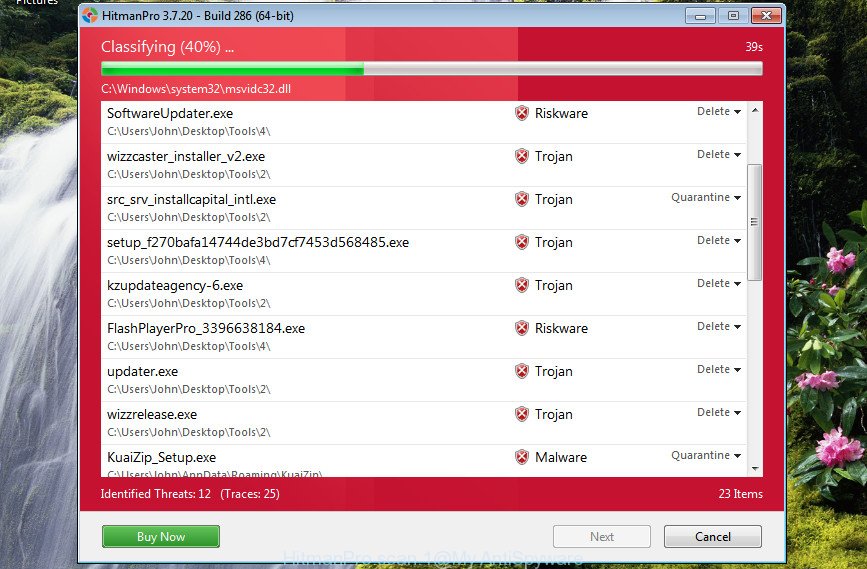
- Visit the page linked below to download HitmanPro. Save it to your Desktop.
- Once the download is finished, double click the Hitman Pro icon. Once this tool is launched, click “Next” button to start scanning your computer for the NextBrowsers browser hijacker. This process can take some time, so please be patient. During the scan Hitman Pro will search for threats exist on your personal computer.
- After Hitman Pro has completed scanning your PC system, HitmanPro will display a scan report. In order to delete all threats, simply click “Next” button. Now click the “Activate free license” button to begin the free 30 days trial to remove all malware found.
Use MalwareBytes Anti-Malware to remove NextBrowsers hijacker
If you are still having problems with the NextBrowsers browser hijacker — or just wish to scan your computer occasionally for browser hijacker and other malware — download MalwareBytes Anti Malware. It’s free for home use, and identifies and removes various unwanted apps that attacks your device or degrades PC performance. MalwareBytes can get rid of adware, PUPs as well as malicious software, including ransomware and trojans.
Please go to the link below to download the latest version of MalwareBytes Anti-Malware (MBAM) for Windows. Save it on your Desktop.
327060 downloads
Author: Malwarebytes
Category: Security tools
Update: April 15, 2020
Once the download is done, close all applications and windows on your computer. Open a directory in which you saved it. Double-click on the icon that’s named MBSetup as displayed on the screen below.
![]()
When the installation starts, you’ll see the Setup wizard which will help you install Malwarebytes on your personal computer.
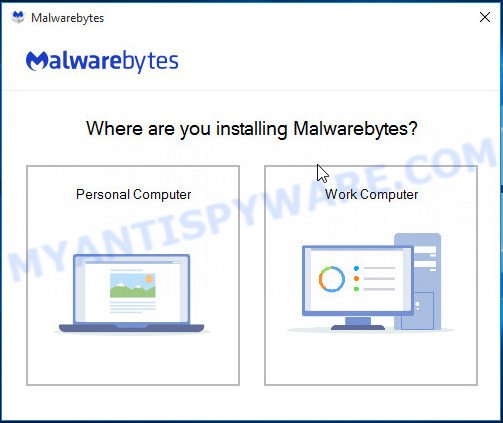
Once setup is finished, you will see window like below.
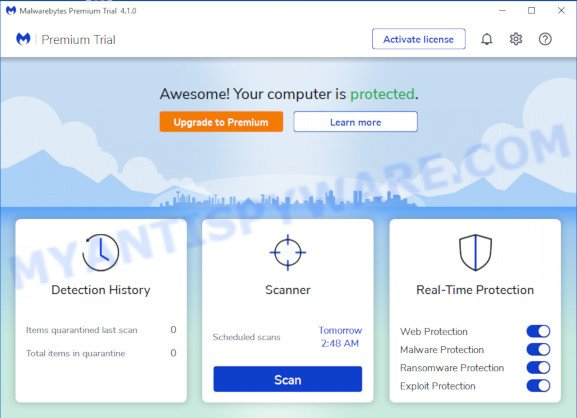
Now click the “Scan” button for checking your computer for the NextBrowsers browser hijacker. During the scan MalwareBytes Anti-Malware (MBAM) will search for threats exist on your computer.
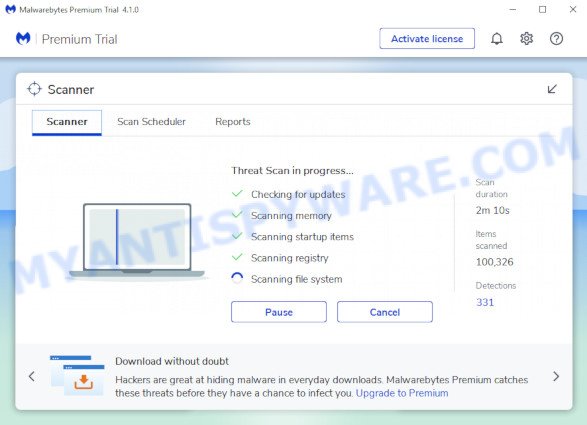
Once the system scan is finished, MalwareBytes will open a list of all items detected by the scan. Review the scan results and then click “Quarantine” button.
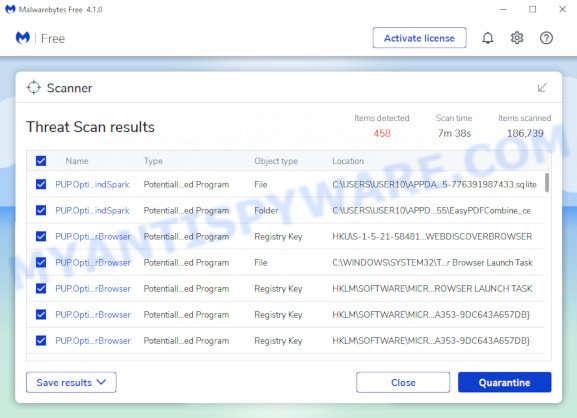
The Malwarebytes will now start to delete NextBrowsers browser hijacker. When disinfection is finished, you may be prompted to restart your PC.

The following video explains few simple steps on how to delete browser hijacker, adware and other malicious software with MalwareBytes Anti Malware.
How to stop NextBrowsers redirect
One of the worst things is the fact that you cannot stop any unwanted and malicious web pages using only built-in Microsoft Windows capabilities. However, there is an application out that you can use to stop annoying web-browser redirects, ads and popups in any modern browsers including IE, Chrome, MS Edge and Mozilla Firefox. It’s called Adguard and it works very well.
Download AdGuard on your computer from the following link.
26841 downloads
Version: 6.4
Author: © Adguard
Category: Security tools
Update: November 15, 2018
When downloading is finished, start the downloaded file. You will see the “Setup Wizard” screen as shown in the figure below.

Follow the prompts. When the install is done, you will see a window like below.

You can click “Skip” to close the setup application and use the default settings, or click “Get Started” button to see an quick tutorial which will allow you get to know AdGuard better.
In most cases, the default settings are enough and you do not need to change anything. Each time, when you start your PC system, AdGuard will start automatically and stop unwanted advertisements, block NextBrowsers redirects, as well as other harmful or misleading webpages. For an overview of all the features of the program, or to change its settings you can simply double-click on the AdGuard icon, that may be found on your desktop.
Finish words
After completing the tutorial outlined above, your PC should be clean from this browser hijacker and other malware. The Google Chrome, IE, Microsoft Edge and Firefox will no longer open the NextBrowsers web-page on startup. Unfortunately, if the guide does not help you, then you have caught a new hijacker, and then the best way – ask for help.
Please create a new question by using the “Ask Question” button in the Questions and Answers. Try to give us some details about your problems, so we can try to help you more accurately. Wait for one of our trained “Security Team” or Site Administrator to provide you with knowledgeable assistance tailored to your problem with the NextBrowsers hijacker.


















